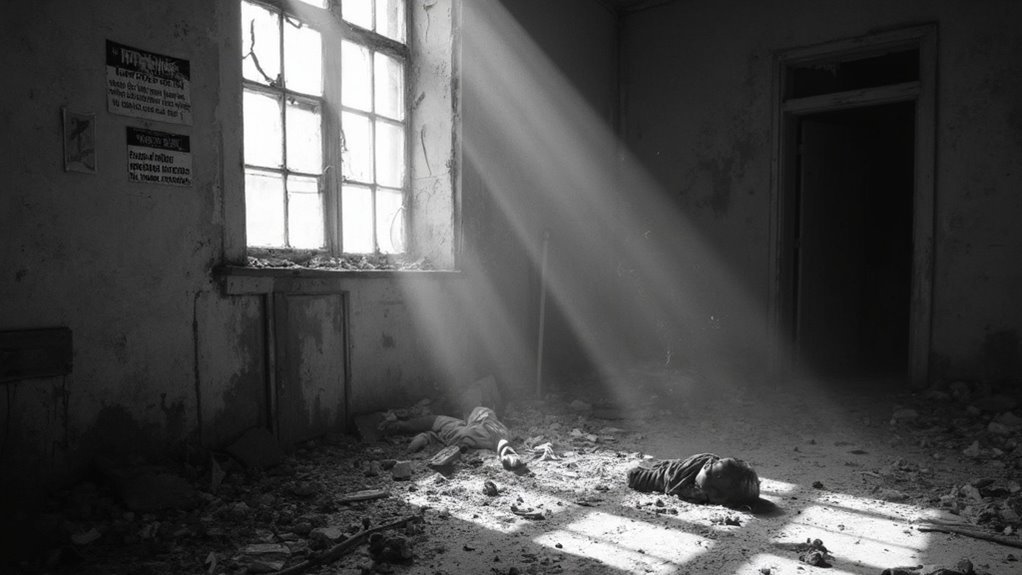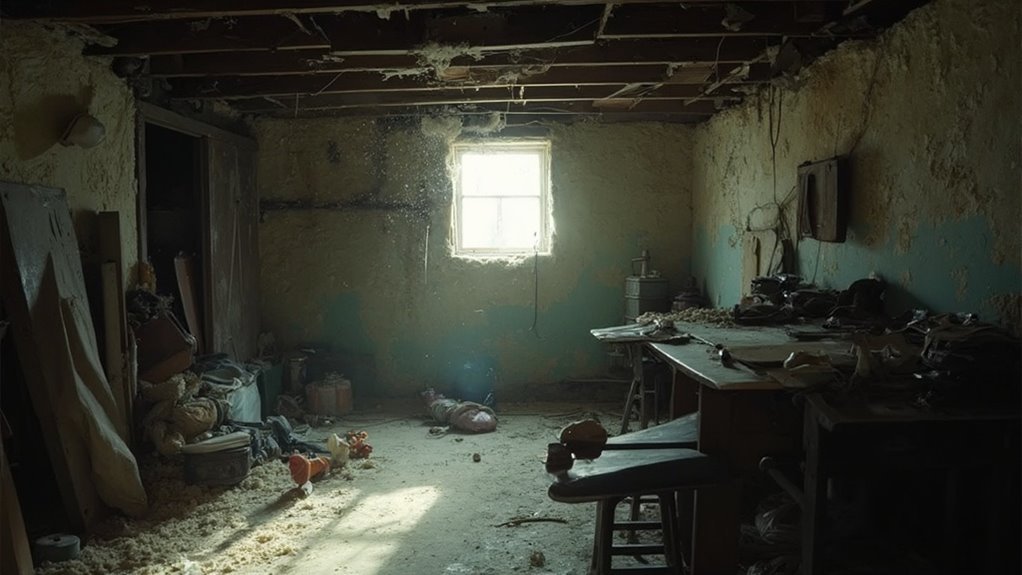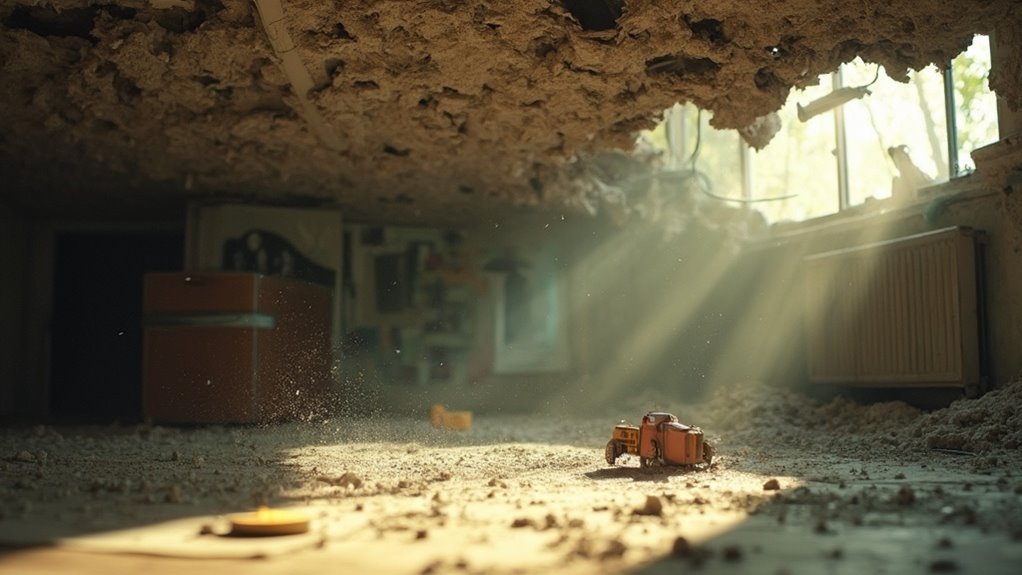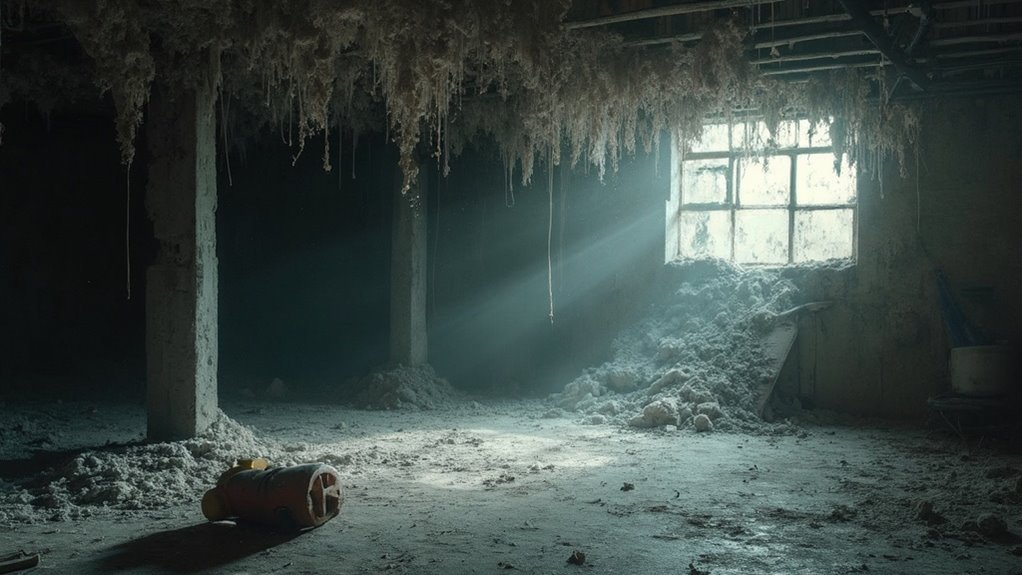Ignoring asbestos abatement can put your family in serious danger. Asbestos exposure is linked to deadly diseases like lung cancer and mesothelioma, and symptoms often don't surface for decades. Even brief exposure can trigger these health issues. Without professional abatement, you're at risk of improper handling, which could worsen the situation and lead to environmental contamination. Certified experts guarantee safe removal and compliance with regulations, protecting both your family and the community. The stakes are high, and understanding the implications can help you make informed choices for your home. Uncovering more about this topic will guide your next steps.
Health Risks of Asbestos

Asbestos exposure poses significant health risks that can lead to serious and often fatal diseases. When you breathe in asbestos fibers, they can become lodged in your lungs, causing inflammation and scarring over time. This can manifest as asbestosis, a chronic lung disease, or lead to more severe conditions like mesothelioma and lung cancer. Asbestos symptoms often don't show up for 20 to 50 years after exposure, making it essential to understand potential exposure sources, such as older buildings, insulation materials, and certain industrial products. Additionally, homes built before the 1980s often contain asbestos, increasing the likelihood of exposure.
Furthermore, you should be aware that even small amounts of asbestos can trigger these diseases, particularly mesothelioma, which has no safe exposure level. The combination of asbestos exposure and smoking dramatically increases your risk of developing lung cancer. All asbestos fibers are harmful if breathed, and non-malignant lung conditions, such as pleural plaques and chronic obstructive pulmonary disease (COPD), can likewise arise from prolonged exposure. It's critical to recognize that asbestos is classified as a known human carcinogen, highlighting the importance of addressing these risks proactively. Ignoring asbestos can lead to significant health consequences, along with costly remediation efforts down the line.
Importance of Professional Abatement
Exposure to asbestos presents significant health risks, making the management of asbestos-containing materials a top priority for property owners. Relying on certified professionals for asbestos abatement is essential to guarantee safety and compliance with regulations. These experts possess extensive experience and specialized training in effective abatement techniques, allowing them to handle asbestos safely and efficiently.
Certified professionals understand the complex regulations set forth by the EPA and OSHA, guaranteeing that your property adheres to legal requirements. They develop thorough abatement plans that outline safe removal procedures, utilizing specialized equipment like HEPA vacuums and personal protective gear to prevent fiber release. Their knowledge of safety protocols minimizes the risk of exposure during the process.
Furthermore, professional abatement services provide detailed inspections and testing, identifying areas that require immediate attention. By entrusting this task to trained technicians, you mitigate potential legal and financial liabilities while protecting your family's health. Ultimately, engaging certified professionals for asbestos abatement not only safeguards your home but also preserves its market value. Asbestos contamination can significantly lower property value, making it crucial to act promptly. Investing in their expertise is a proactive step toward a safer living environment.
Consequences of Poor Practices

Neglecting proper asbestos abatement practices can expose you and others to serious health risks, including lung cancer and other respiratory diseases. Beyond the immediate health threats, you could face significant legal and financial consequences if regulations are violated, including hefty fines and potential loss of licenses. Environmental contamination from improper handling not only endangers public health but additionally incurs further legal repercussions and cleanup costs.
Health Risks to Everyone
Improper handling of asbestos-containing materials can have severe health consequences for everyone involved, not just those directly working with the material. When asbestos fibers are disturbed, they can become airborne, increasing the risk of exposure for your family and neighbors. This exposure heightens the chances of developing serious conditions, including lung cancer and mesothelioma, which may take decades to manifest.
Even nonmalignant lung disorders, like asbestosis, can arise from prolonged exposure and lead to significant health issues. The risks aren't limited to workers; family members of those exposed likewise face dangers, especially if asbestos fibers are brought home on clothing or equipment.
Community awareness plays an essential role in addressing these risks. By understanding the dangers of asbestos and implementing proper abatement practices, you contribute to overall family safety and community health. It's critical to guarantee that only trained and accredited professionals handle asbestos removal to minimize exposure risks effectively. Ignoring these precautions not only jeopardizes health but can have long-lasting effects on your loved ones and the wider community. Stay informed, advocate for safe practices, and protect your family from the hidden dangers of asbestos.
Legal and Financial Repercussions
What happens when asbestos abatement practices go awry? You may face significant legal liabilities and financial penalties. Failing to comply with federal and state regulations can lead to severe consequences, including hefty fines and potential criminal charges. For instance, if a contractor improperly removes or disposes of asbestos, they could incur fines that total hundreds of thousands of dollars. Repeated violations can double these penalties, and serious infractions may even result in imprisonment for up to five years, along with fines reaching $250,000.
Moreover, negligence during asbestos removal can open the door to criminal prosecution, especially if workers are exposed to hazardous conditions. Companies might as well face reputational damage or lose their licenses, complicating their future operations. You should always hire trained and accredited professionals for asbestos abatement to avoid these costly repercussions. Ignoring proper practices not only jeopardizes your family's health but additionally puts you at risk for extensive legal and financial fallout. Make wise choices to protect your family and your finances.
Environmental Contamination Issues
Even a single instance of poor asbestos abatement can lead to widespread environmental contamination, affecting air, soil, and water quality. When asbestos fibers are released into the air, they can be inhaled, posing serious health risks not just to those directly involved but likewise to the surrounding community. These fibers can travel long distances through wind or water, contaminating areas far from their source, and because of their non-biodegradable nature, they remain a persistent threat for years.
Natural disasters, like floods and strong winds, can further spread asbestos fibers, leading to contamination of local drinking water sources. Sudden destruction of contaminated buildings can release these harmful fibers into the environment, exacerbating the situation. Poor abatement practices greatly increase the potential for exposure, particularly among workers and nearby residents.
The environmental impact of asbestos is profound, contributing to serious health issues like lung cancer and mesothelioma, which can take decades to manifest. Understanding these risks emphasizes the importance of professional removal and proper handling of asbestos materials to safeguard your family and community from these dangers.
Assessing Abatement Needs
Before initiating any renovation or demolition project, it's vital to assess the need for asbestos abatement. Buildings constructed before 1987 are likely to contain asbestos, making thorough asbestos testing paramount. Certified Asbestos Investigators (CAIs) conduct surveys to identify asbestos-containing materials (ACMs) and provide detailed written evaluations that outline the location and condition of any damaged materials. This survey should include a complete visual examination and laboratory analysis of samples.
Regulatory compliance is likewise a key factor. In New York City, the Department of Environmental Protection (DEP) regulates asbestos abatement. You must submit an ACP-7 Asbestos Project Notification Form to the DEP if ACM exists, and guarantee that any abatement strategies comply with their regulations. If your building is post-1987 and has no known ACM, you'll need an Asbestos Exemption Certification.
Finally, employing professional services is vital. Hire trained asbestos professionals and licensed abatement contractors for the safe removal of ACM. Independent air-monitoring firms are required to oversee the work, guaranteeing a safe environment for everyone involved. By taking these steps, you can effectively assess your abatement needs and protect your family from potential asbestos exposure.
Benefits of Asbestos Removal

Addressing asbestos abatement needs sets the stage for understanding the significant benefits of asbestos removal. One of the most important advantages is the drastic reduction in asbestos-related diseases, such as asbestosis and lung cancer. By employing effective removal techniques, you eliminate exposure sources, safeguarding both your family and workers from harmful asbestos fibers. This is particularly important for vulnerable populations, like children and the elderly, who are at higher risk.
Moreover, investing in asbestos removal not only improves property value but also mitigates future costs. You avoid potential legal liabilities associated with non-compliance, ensuring peace of mind that your property meets all safety standards. Furthermore, proper removal prevents environmental contamination and aligns with sustainable practices, contributing to a healthier planet.
It's imperative to dispel asbestos myths that may downplay these risks. The reality is that professional abatement services are fundamental for ensuring long-term safety. By removing hazardous materials now, you minimize future exposure risks and protect your community from asbestos-related health issues. Ultimately, the benefits of asbestos removal extend beyond health, influencing legal, financial, and environmental aspects of your life.
Regulatory Compliance Requirements
Steering through the regulatory environment for asbestos abatement is fundamental for guaranteeing safety and compliance. Various federal, state, and local regulatory bodies collaborate to create an all-encompassing regulatory framework that governs asbestos abatement practices. The Occupational Safety and Health Administration (OSHA) and the Environmental Protection Agency (EPA) set forth vital training requirements and site protection standards, while state governments issue specific licenses and permits necessary for conducting abatement work.
Before starting any project, it's important to submit a notification form at least 10 days in advance, especially for larger projects. Compliance audits are often conducted to confirm that asbestos abatement companies adhere to these regulations. A certified supervisor must oversee all activities, guaranteeing workers are trained under stringent EPA guidelines.
Failing to comply with these regulations can result in serious penalties, including fines and legal repercussions. Local enforcement agencies closely monitor projects, which may have stricter standards than federal guidelines. Understanding and adhering to these compliance requirements not only protects your family but additionally helps avoid potential legal complications, assuring that any asbestos abatement is carried out safely and effectively.
Identifying High-Risk Areas

When identifying high-risk areas for asbestos abatement, you need to focus on common locations like attics, basements, and roofing materials. Look for signs of disturbance, such as visible damage or renovation activity, which can release harmful fibers into the air. Regular inspections are crucial to guarantee these areas are assessed and managed properly to minimize health risks.
Common Asbestos Locations
Identifying high-risk areas for asbestos in homes and commercial buildings necessitates a keen understanding of where this hazardous material is commonly found. In residential properties, attics, roofs, and basements often contain asbestos because of its fire-resistant properties. You might find it in pipe insulation, vinyl floor tiles, and wall panels, especially in homes built before the 1980s. When considering renovations, be mindful that disturbing these materials can pose serious risks.
In commercial buildings, such as office spaces and schools constructed prior to the 1980s, asbestos is frequently present in ceiling tiles, insulation, and heating systems. Industrial facilities and warehouses built during this time may likewise contain asbestos, particularly in roofs and insulation. This increases the risk during renovations or demolitions, making asbestos testing crucial before starting any project.
Public buildings, including hospitals and libraries, are not exempt from these risks. Many still contain asbestos in their structures, which can endanger occupants. By identifying these common locations, you can take proactive measures to guarantee safety and prevent exposure for you and your family.
Signs of Disturbance
Damaged asbestos-containing materials (ACMs) pose a significant risk in both residential and commercial settings, often signaling potential hazards in your environment. Recognizing disturbance signs is vital for effective asbestos identification. When ACMs are cut, sanded, or manipulated, they can release dangerous fibers into the air, particularly during renovations or demolitions.
Here are some common signs of disturbance to watch for:
| Disturbance Signs | Indicators of Risk |
|---|---|
| Visible damage to ACMs | Cracks, tears, or discoloration |
| Dust or debris accumulation | Fine particles in the air |
| Operations near ACMs | Drilling, sawing, or scraping |
| Unusual sounds during activity | Cracking or popping noises |
| Reported respiratory issues | Coughing, shortness of breath |
If you observe any of these signs, it's imperative to act swiftly. High-risk areas, such as ceilings, walls, and flooring, require immediate attention. Addressing these disturbances not only protects your health but likewise prevents broader exposure risks to others sharing your space. Ignoring these warnings can lead to severe health issues related to asbestos exposure.
Taking Action for Safety
Taking action for safety during asbestos abatement is crucial to protect both workers and the surrounding community. Implementing effective safety measures not only safeguards your family but likewise minimizes risks associated with asbestos exposure. Here are four critical steps to guarantee safety during the process:
- Use Wet Methods: Always apply wet methods when handling asbestos materials. This helps to minimize fiber release and reduces airborne contamination.
- Isolate Work Areas: Inform your neighbors and isolate the work areas by sealing doors and windows or using temporary barriers to prevent asbestos fibers from spreading.
- Protective Gear: Confirm all workers wear appropriate personal protective equipment (PPE), including disposable protective clothing, respirators, and gloves, to avoid skin and inhalation exposure.
- Professional Handling: Only allow trained and accredited professionals to manage disturbed or damaged asbestos-containing materials. Their expertise guarantees safe removal and disposal.
Frequently Asked Questions
How Can I Identify Asbestos in My Home?
Finding asbestos in your home can feel like hunting for a needle in a haystack. Use identification methods like visual checks and professional asbestos testing to pinpoint potential hazards hidden in materials and structures.
What Are the Costs Associated With Asbestos Abatement?
Asbestos testing reveals contamination levels, guiding your remediation expenses. Costs vary widely, from initial inspections to full home abatement, influenced by material type, location, and safety requirements. Prepare for potential additional repair and relocation costs.
How Long Does the Abatement Process Typically Take?
"Time is money," and understanding the abatement timeline is essential. Typically, project duration varies from a few days to weeks based on size, complexity, and asbestos condition, emphasizing the need for thorough planning and execution.
Can I Live in My Home During Abatement?
You typically can't live in your home during asbestos abatement because of safety risks. If you're planning renovations, consult professionals for proper assessment and containment to guarantee asbestos safety and protect your family's health.
What Should I Do if I Suspect Asbestos Exposure?
If you suspect asbestos exposure, monitor for asbestos symptoms like coughing or shortness of breath. Prioritize exposure prevention by avoiding disturbed materials, limiting access to affected areas, and consulting certified professionals for assessment and removal.
